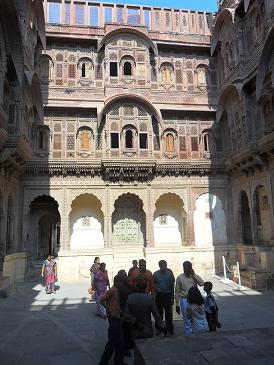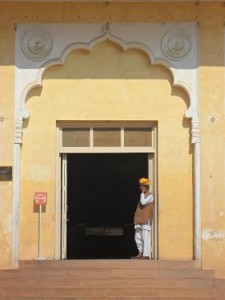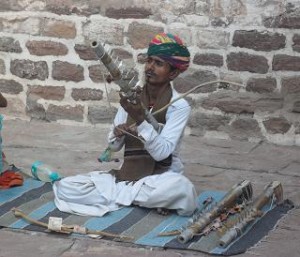-
A Spirit as Rare as the Rains: Creating a Contemporary Paradigm for Cultural Identity
Posted on July 9, 2015 We are all absolutely delighted that Maharaja Gaj Singh, Managing Trustee of the Mehrangarh Museum Trust in Jodhpur, will be giving a keynote address at the International Conference of National Trusts on 7 September. It is nearly five years since my visit to Mehrangarh and I look forward to hearing how things have developed since then.
We are all absolutely delighted that Maharaja Gaj Singh, Managing Trustee of the Mehrangarh Museum Trust in Jodhpur, will be giving a keynote address at the International Conference of National Trusts on 7 September. It is nearly five years since my visit to Mehrangarh and I look forward to hearing how things have developed since then.I had the honour of meeting the Maharaja, or Bapji as he is affectionately called in 2010, and remember him speaking passionately about the need for education, the economic impact of a good quality environment and his determination to secure water supply in this desert region using community-based traditional water systems to help make villages self-reliant.
It was easy to understand why Mehrangarh is considered one of the best heritage sites in India. I remember remarking at the time on the numbers of families visiting en masse, the excellent audio guide with personal testimonies from members of the royal family and the abundance of extraordinary stories: The chap who volunteered to be buried alive in the foundations to appease the gods, the handprints of the last widows to perform sati on their husband’s funeral pyre in 1843, Bapji’s recollection of his coronation and the great poise he showed, raga (the combination of poetry, music and painting), and the royal palanquin (sedan chair) taken to London in 1925 to transport the then Maharani to and from her specially curtained Rolls Royce.
 This strict observance of purdah of course caused a wave of curiosity and everyone wanted a photograph. The best the paparazzi could manage was a shot of her ankle, which was duly published but the outraged royal party from Jodhpur bought up every edition of the paper!
This strict observance of purdah of course caused a wave of curiosity and everyone wanted a photograph. The best the paparazzi could manage was a shot of her ankle, which was duly published but the outraged royal party from Jodhpur bought up every edition of the paper!Also fabulous to see the Fort being used for community, clan, religious and family occasions, underlining the Maharaja’s social welfare role. Everyone I met seemed to agree the need to ‘bottle Bapji’.
Well, the next best thing is to bring him to Cambridge to share his experience and enthusiasm with our ICNT delegates!!! There is still time to book your place so why not come and join us?
The Maharaja will be drawing on his experience of life in western Rajasthan, India’s largest state, to speak to the conference theme of ‘cultural identity’. People here have always had a strong, intricate and multi-layered sense of cultural identity, forged in the brutal heat of the desert, and perhaps kept invigorated, as Maharaja Gaj Singh has said, by “a spirit as rare as our rains.”
Scholars confirm this, though less poetically, pointing out that although Rajasthan sits at the confluence of numerous ancient trade routes linking the Middle East with central, eastern and southeast Asia, and had substantial interaction with the Mughal kingdoms, other Indian regions, and the colonial British, it has nevertheless maintained a highly distinctive cultural identity that is based both on the arts, culture and symbolism of the kingdom, and the vibrant arts and unique traditions of the desert.
 There are now, however, assaults from all sides. Traditional arts, once sustained by their role within their communities, are suffering from lack of alternative patronage. Children in even the most remote desert areas, not to mention the larger villages and cities, are tuned into the national and international worlds through internet, TV, and social media. The unique habitats which provided the context for traditional identity often suffer from poverty and lack of basic civic infrastructure, and the hard-won knowledge relating to sustainable agriculture, water conservation, and ecologically appropriate housing is fast losing ground. The younger generation is drawn to what it sees as the glamour of other worlds, and has little interest in remaining home to serve as a museum object for wandering tourists. Irreplaceable knowledge and traditions are severely damaged, and with their loss much of the region’s cultural moorings will give way.
There are now, however, assaults from all sides. Traditional arts, once sustained by their role within their communities, are suffering from lack of alternative patronage. Children in even the most remote desert areas, not to mention the larger villages and cities, are tuned into the national and international worlds through internet, TV, and social media. The unique habitats which provided the context for traditional identity often suffer from poverty and lack of basic civic infrastructure, and the hard-won knowledge relating to sustainable agriculture, water conservation, and ecologically appropriate housing is fast losing ground. The younger generation is drawn to what it sees as the glamour of other worlds, and has little interest in remaining home to serve as a museum object for wandering tourists. Irreplaceable knowledge and traditions are severely damaged, and with their loss much of the region’s cultural moorings will give way.The Mehrangarh Museum Trust (MMT), which operates both Jodhpur’s 15th century Mehrangarh Fort and the 12th century Ahhichatragarh Fort in Nagaur, is determined to stem the tide, and has made these monuments into repositories and guardians of the artistic and cultural history of the region. The Trust is acutely aware, however, that no cultural identity can remain viable in a vacuum.
 Operating under the leadership of Maharaja Gaj Singh, the Mehrangarh and Nagaur forts are thus serving as the centres for multiple creative new means for not only reinforcing and preserving the unique cultural traditions of the region, but for finding ways to keep the identity alive and kicking by infusing it with new energy, new excitement, and new involvement with the rest of the world. The keynote address will describe these (and demonstrate some with audio-visuals), and present MMT as one successful model of the way in which a heritage trust can provide multiple ways to help cultural identity evolve and remain viable in a contemporary context — perhaps the single most important role for a heritage trust in the 21st century .
Operating under the leadership of Maharaja Gaj Singh, the Mehrangarh and Nagaur forts are thus serving as the centres for multiple creative new means for not only reinforcing and preserving the unique cultural traditions of the region, but for finding ways to keep the identity alive and kicking by infusing it with new energy, new excitement, and new involvement with the rest of the world. The keynote address will describe these (and demonstrate some with audio-visuals), and present MMT as one successful model of the way in which a heritage trust can provide multiple ways to help cultural identity evolve and remain viable in a contemporary context — perhaps the single most important role for a heritage trust in the 21st century .

 44 (0)20 7824 7157
44 (0)20 7824 7157